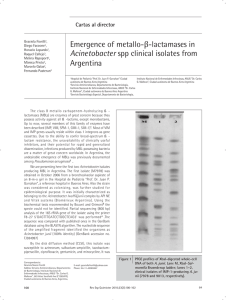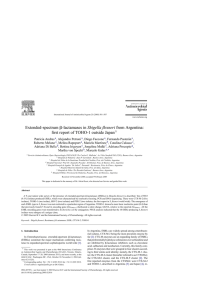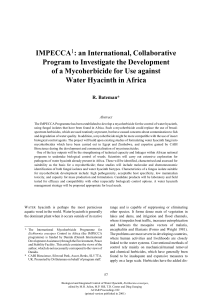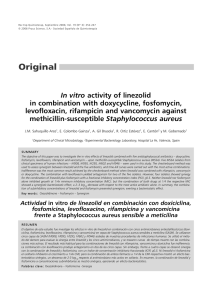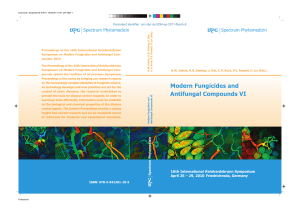Fluoroquinolone-resistant Streptococcus agalactiae isolates from
Anuncio
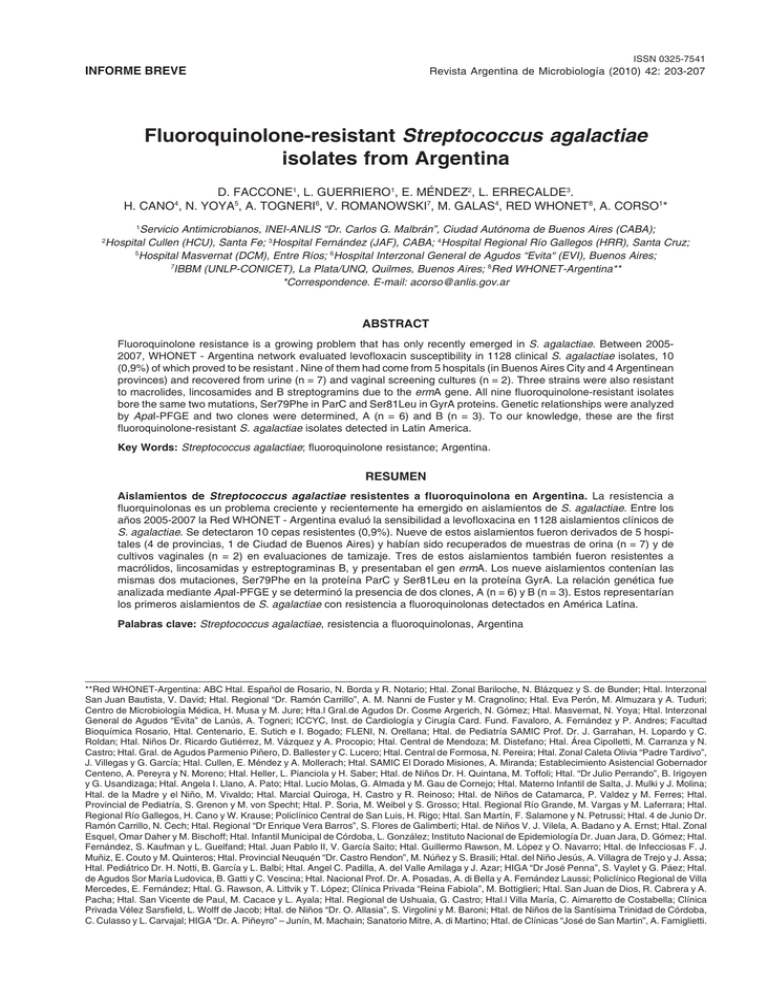
Fluoroquinolone-resistant Streptococcus agalactiae from Argentina INFORME BREVE 203 ISSN 0325-7541 Revista Argentina de Microbiología (2010) 42: 203-207 Fluoroquinolone-resistant Streptococcus agalactiae isolates from Argentina D. FACCONE1, L. GUERRIERO1, E. MÉNDEZ2, L. ERRECALDE3. H. CANO4, N. YOYA5, A. TOGNERI6, V. ROMANOWSKI7, M. GALAS4, RED WHONET8, A. CORSO1* Servicio Antimicrobianos, INEI-ANLIS “Dr. Carlos G. Malbrán”, Ciudad Autónoma de Buenos Aires (CABA); Hospital Cullen (HCU), Santa Fe; 3Hospital Fernández (JAF), CABA; 4Hospital Regional Río Gallegos (HRR), Santa Cruz; 5 Hospital Masvernat (DCM), Entre Ríos; 6Hospital Interzonal General de Agudos “Evita“ (EVI), Buenos Aires; 7 IBBM (UNLP-CONICET), La Plata/UNQ, Quilmes, Buenos Aires; 8Red WHONET-Argentina** *Correspondence. E-mail: acorso@anlis.gov.ar 1 2 ABSTRACT Fluoroquinolone resistance is a growing problem that has only recently emerged in S. agalactiae. Between 20052007, WHONET - Argentina network evaluated levofloxacin susceptibility in 1128 clinical S. agalactiae isolates, 10 (0,9%) of which proved to be resistant . Nine of them had come from 5 hospitals (in Buenos Aires City and 4 Argentinean provinces) and recovered from urine (n = 7) and vaginal screening cultures (n = 2). Three strains were also resistant to macrolides, lincosamides and B streptogramins due to the ermA gene. All nine fluoroquinolone-resistant isolates bore the same two mutations, Ser79Phe in ParC and Ser81Leu in GyrA proteins. Genetic relationships were analyzed by ApaI-PFGE and two clones were determined, A (n = 6) and B (n = 3). To our knowledge, these are the first fluoroquinolone-resistant S. agalactiae isolates detected in Latin America. Key Words: Streptococcus agalactiae; fluoroquinolone resistance; Argentina. RESUMEN Aislamientos de Streptococcus agalactiae resistentes a fluoroquinolona en Argentina. La resistencia a fluorquinolonas es un problema creciente y recientemente ha emergido en aislamientos de S. agalactiae. Entre los años 2005-2007 la Red WHONET - Argentina evaluó la sensibilidad a levofloxacina en 1128 aislamientos clínicos de S. agalactiae. Se detectaron 10 cepas resistentes (0,9%). Nueve de estos aislamientos fueron derivados de 5 hospitales (4 de provincias, 1 de Ciudad de Buenos Aires) y habían sido recuperados de muestras de orina (n = 7) y de cultivos vaginales (n = 2) en evaluaciones de tamizaje. Tres de estos aislamientos también fueron resistentes a macrólidos, lincosamidas y estreptograminas B, y presentaban el gen ermA. Los nueve aislamientos contenían las mismas dos mutaciones, Ser79Phe en la proteína ParC y Ser81Leu en la proteína GyrA. La relación genética fue analizada mediante ApaI-PFGE y se determinó la presencia de dos clones, A (n = 6) y B (n = 3). Estos representarían los primeros aislamientos de S. agalactiae con resistencia a fluoroquinolonas detectados en América Latina. Palabras clave: Streptococcus agalactiae, resistencia a fluoroquinolonas, Argentina **Red WHONET-Argentina: ABC Htal. Español de Rosario, N. Borda y R. Notario; Htal. Zonal Bariloche, N. Blázquez y S. de Bunder; Htal. Interzonal San Juan Bautista, V. David; Htal. Regional “Dr. Ramón Carrillo”, A. M. Nanni de Fuster y M. Cragnolino; Htal. Eva Perón, M. Almuzara y A. Tuduri; Centro de Microbiología Médica, H. Musa y M. Jure; Hta.l Gral.de Agudos Dr. Cosme Argerich, N. Gómez; Htal. Masvernat, N. Yoya; Htal. Interzonal General de Agudos “Evita” de Lanús, A. Togneri; ICCYC, Inst. de Cardiología y Cirugía Card. Fund. Favaloro, A. Fernández y P. Andres; Facultad Bioquímica Rosario, Htal. Centenario, E. Sutich e I. Bogado; FLENI, N. Orellana; Htal. de Pediatría SAMIC Prof. Dr. J. Garrahan, H. Lopardo y C. Roldan; Htal. Niños Dr. Ricardo Gutiérrez, M. Vázquez y A. Procopio; Htal. Central de Mendoza; M. Distefano; Htal. Área Cipolletti, M. Carranza y N. Castro; Htal. Gral. de Agudos Parmenio Piñero, D. Ballester y C. Lucero; Htal. Central de Formosa, N. Pereira; Htal. Zonal Caleta Olivia “Padre Tardivo”, J. Villegas y G. García; Htal. Cullen, E. Méndez y A. Mollerach; Htal. SAMIC El Dorado Misiones, A. Miranda; Establecimiento Asistencial Gobernador Centeno, A. Pereyra y N. Moreno; Htal. Heller, L. Pianciola y H. Saber; Htal. de Niños Dr. H. Quintana, M. Toffoli; Htal. “Dr Julio Perrando”, B. Irigoyen y G. Usandizaga; Htal. Angela I. Llano, A. Pato; Htal. Lucio Molas, G. Almada y M. Gau de Cornejo; Htal. Materno Infantil de Salta, J. Mulki y J. Molina; Htal. de la Madre y el Niño, M. Vivaldo; Htal. Marcial Quiroga, H. Castro y R. Reinoso; Htal. de Niños de Catamarca, P. Valdez y M. Ferres; Htal. Provincial de Pediatría, S. Grenon y M. von Specht; Htal. P. Soria, M. Weibel y S. Grosso; Htal. Regional Río Grande, M. Vargas y M. Laferrara; Htal. Regional Río Gallegos, H. Cano y W. Krause; Policlínico Central de San Luis, H. Rigo; Htal. San Martín, F. Salamone y N. Petrussi; Htal. 4 de Junio Dr. Ramón Carrillo, N. Cech; Htal. Regional “Dr Enrique Vera Barros”, S. Flores de Galimberti; Htal. de Niños V. J. Vilela, A. Badano y A. Ernst; Htal. Zonal Esquel, Omar Daher y M. Bischoff; Htal. Infantil Municipal de Córdoba, L. González; Instituto Nacional de Epidemiología Dr. Juan Jara, D. Gómez; Htal. Fernández, S. Kaufman y L. Guelfand; Htal. Juan Pablo II, V. García Saito; Htal. Guillermo Rawson, M. López y O. Navarro; Htal. de Infecciosas F. J. Muñiz, E. Couto y M. Quinteros; Htal. Provincial Neuquén “Dr. Castro Rendon”, M. Núñez y S. Brasili; Htal. del Niño Jesús, A. Villagra de Trejo y J. Assa; Htal. Pediátrico Dr. H. Notti, B. García y L. Balbi; Htal. Angel C. Padilla, A. del Valle Amilaga y J. Azar; HIGA “Dr José Penna”, S. Vaylet y G. Páez; Htal. de Agudos Sor María Ludovica, B. Gatti y C. Vescina; Htal. Nacional Prof. Dr. A. Posadas, A. di Bella y A. Fernández Laussi; Policlínico Regional de Villa Mercedes, E. Fernández; Htal. G. Rawson, A. Littvik y T. López; Clínica Privada “Reina Fabiola”, M. Bottiglieri; Htal. San Juan de Dios, R. Cabrera y A. Pacha; Htal. San Vicente de Paul, M. Cacace y L. Ayala; Htal. Regional de Ushuaia, G. Castro; Htal.l Villa María, C. Aimaretto de Costabella; Clínica Privada Vélez Sarsfield, L. Wolff de Jacob; Htal. de Niños “Dr. O. Allasia”, S. Virgolini y M. Baroni; Htal. de Niños de la Santísima Trinidad de Córdoba, C. Culasso y L. Carvajal; HIGA “Dr. A. Piñeyro” – Junín, M. Machain; Sanatorio Mitre, A. di Martino; Htal. de Clínicas “José de San Martin”, A. Famiglietti. 204 Streptococcus agalactiae usually colonizes gastrointestinal, respiratory and urogenital human tracts causing different kinds of infections. Urogenital colonization of pregnant women with S. agalactiae is a critical risk factor for invasive neonatal disease, being antimicrobial prophylaxis recommended during delivery (2, 11). S. agalactiae is traditionally considered to be a neonatal pathogen, although recent increasing incidence of infections in adults was observed in the USA, especially in patients with underlying medical conditions (12). Fluoroquinolone resistance is a growing problem in human pathogens and S. agalactiae isolates with this phenotype have recently emerged in a few countries. The main resistance mechanisms known today are mutations in the quinolone resistance- determining region (QRDR) of ParC protein in positions Ser79 and Asp83 (1, 6, 14, 15). Additional mutations in Ser81 and Glu85 of GyrA protein are also related to fluoroquinolone resistance (1, 6, 15). In 2005, WHONET - Argentina group (67 Hospitals) started the national surveillance of fluoroquinolone resistance in S. agalactiae. Levofloxacin susceptibility was evaluated by disk diffusion in 1128 S. agalactiae clinical isolates between 2005-2007, detecting fluoroquinolone resistance in 10 (0.9%) isolates (3). Nine of them were submitted to the National Reference Laboratory (INEI) in order to characterize both the molecular mechanisms involved in fluoroquinolone resistance and their genetic relationship. Isolates were recovered from 5 hospitals located in Buenos Aires City and in the provinces of Santa Fe, Santa Cruz, Entre Ríos and Buenos Aires. Seven S. agalactiae isolates were recovered from urine and two from vaginal screening cultures. Minimal inhibitory concentration (MIC) was determined by the agar dilution method according to CLSI guidelines for penicillin, cefotaxime, erythromycin, azithromycin, clindamycin, norfloxacin, ofloxacin, ciprofloxacin, levofloxacin, gatifloxacin and moxifloxacin (3). Briefly, plates containing Mueller-Hinton agar plus 5% sheep blood and two-fold antibiotic dilutions were inoculated and incubated during 18-24 h at 35 °C in a 5% CO2 atmosphere (3). Streptococcus pneumoniae ATCC 49619 and Staphylococcus aureus ATCC 29213 were used as control strains. Macrolide resistance phenotypes were evaluated by disk diffusion positioning erythromycin (15 µg) and clindamycin (2 µg) disks 12 mm edge to edge (3). Expression of efflux pump was evaluated comparing the MIC of ciprofloxacin alone and supplemented with 20 mg/l of reserpine. Standard PCR was employed to detect the presence of ermA, ermB and mefA genes (13). QRDR sequences of parC and gyrA genes were determined using primers described previously (6). The S. agalactiae 2603V/R sequence (NC_004116) was used for DNA and protein sequence comparisons. Clonal relationships among the isolates were evaluated digesting genomic DNA with ApaI en- Revista Argentina de Microbiología (2010) 42: 203-207 zyme. DNA fragments were resolved on 1% agarose gel using a CHEF-DR III apparatus (Bio-Rad Laboratories, Hercules, CA) applying a 2 to 20 second-switch time, using 6 V/cm during 20 h at 14 °C. DNA patterns were analyzed with Bionumerics software using Dice coefficient and 1% tolerance. Isolates were considered genetically indistinguishable when they showed identical PFGE profiles and were assigned the same clonal subtype (e.g. subtype A1). PFGE profiles with 1-6 bands of difference were considered possibly related and were assigned to the same clonal type but different clonal subtype (e.g. subtype A1, A2). Isolates whose PFGE profiles differed by more than 6 bands were considered to be unrelated and were assigned different clonal types (e.g. clone A, B). All nine S. agalactiae isolates showed susceptibility to penicillin and cefotaxime (Table 1). Three out of nine strains were resistant to macrolides, erythromycin and azithromycin, but susceptible to clindamycin (Table 1). However, by erythromycin/clindamycin double disk assay, an inducible resistance phenotype to macrolides, lincosamides and streptogramines (iMLSB) was observed. These three isolates showing iMLSB phenotype were positive for the ermA gene and negative for ermB and mefA genes. All nine S. agalactiae isolates were resistant to all the fluoroquinolones assayed; however, different in vitro activities were observed (MIC range): norfloxacin (32-64 mg/l) = ofloxacin (32-64 mg/l) = ciprofloxacin (32-64 mg/l) < levofloxacin (16-32 mg/l) < gatifloxacin (4 mg/l) < moxifloxacin (2 mg/l) (Table 1). Differences were not observed among ciprofloxacin MICs in the presence or in the absence of reserpine, discarding a possible efflux pump activity affected by reserpine (Table 1). The same Ser79Phe and Ser81Leu mutations were detected in all nine isolates in ParC and GyrA proteins respectively (Table 1). Analysis of fluoroquinolone-resistant S. agalactiae isolates by ApaIPFGE established the presence of 2 clonal types named A and B (Figure 1). Six isolates were genetically related and were differentiated in five clonal subtypes, A1 to A5, sharing more than 85% similarity (Table 1; Figure 1). The remaining three isolates showed undistinguishable DNA patterns and were classified as clone B (Figure 1; Table 1). Resistance to penicillin and cephalosporins are still uncommon in S. agalactiae, being amino acidic modifications in pbp genes the main resistance mechanism (4). Macrolide resistance is mainly mediated by Erm methylase or Mef efflux pump. The isolates studied herein and expressing iMLSB-phenotype harboured the ermA gene. Macrolide and lincosamide resistance in S. agalactiae is growing in our country and in 2007 reached 11.3% and 5.2%, respectively (WHONET - Argentina network data). Previous studies from Argentina reported the presence of ermA and ermB methylase genes, MefA efflux pump and more interestingly the emergence of lincosamide HCU HCU HCU M6497 M6394 M6396 M6397 Urine Urine Vaginal Urine Santa Fe Santa Fe Santa Fe Entre Ríos Urine Urine Urine Urine FQ, iMLSb, TET FQ, iMLSb, TET FQ, iMLSb, TET FQ FQ FQ FQ FQ FQ, TET Sample Resistance profile Santa Cruz Vaginal Santa Fe Bs As CABA Santa Fe Province 64 32 64 64 64 64 64 64 32 NOR 64 64 32 64 32 64 64 64 64 32 32 32 32 32 64 64 32 32 OFL CIP 32 32 32 32 32 32 32 32 32 C+R 16 16 16 32 16 32 32 32 32 LEV 4 4 4 4 4 4 4 4 4 GAT 2 2 2 2 2 2 2 2 2 0,06 0,06 0,06 0,06 0,06 0,06 0,06 0,06 0,06 MOX PEN 0,06 0,06 0,06 0,06 0,06 0,06 0,12 0,06 0,06 CTX 4 4 1 0,12 0,12 0,12 0,12 0,12 0,12 ERY 32 32 4 0,25 0,25 0,25 0,25 0,25 0,25 AZI 0,12 0,12 0,12 0,12 0,12 0,12 0,12 0,12 0,12 CLI ermA ermA ermA - - - - - - PCR S-79-F S-79-F S-79-F S-79-F S-79-F S-79-F S-79-F S-79-F S-79-F ParC S-81-L S-81-L S-81-L S-81-L S-81-L S-81-L S-81-L S-81-L S-81-L GyrA B B B A5 A4 A3 A2 A1 A1 type Mutation in QRDR Apa I-PFGE PFGE type, restriction patterns by pulse-field gel electrophoresis using ApaI enzyme. ciprofloxacin; C + R, ciprofloxacin plus reserpine; LEV, levofloxacin; GAT, gatifloxacin; MOX, moxifloxacin; PEN, penicillin; CTX, cefotaxime; ERY, erythromycin; AZI, azithromycin; CLI, clindamycin. ApaI- Masvernat, Entre Ríos; FQ, fluoroquinolones; TET, tetracycline; iMLSb, inducible phenotype of resistance to macrolides, lincosamides and streptogramins B; NOR, norfloxacin; OFL, ofloxacin; CIP, Abbreviations. HCU, Htal. Cullen, Santa Fe; JAF, Htal. Fernández, CABA; EVI, Hosp Interzonal General de Agudos “Evita”, Buenos Aires; HRR, Htal. Regional Río Gallegos, Santa Cruz; DCM, Htal. HRR DCM M6459 EVI HCU JAF M6196 M6405 HCU M6395 M6530 Hospital Isolate MIC (mg/l) Table 1. Sources, susceptibility (MIC), resistance mechanism and genetic relationship data of fluoroquinolone-resistant S. agalactiae. Fluoroquinolone-resistant Streptococcus agalactiae from Argentina 205 206 Revista Argentina de Microbiología (2010) 42: 203-207 Figure 1. Pulsed field gel electrophoresis (PFGE) and genetic relation analysis of fluoroquinolone-resistant S. agalactiae isolates. Genetic relationship analysis among fluoroquinolone-resistant S. agalactiae from Argentina using Dice algorithm and Bionumerics Software. Scale only shows similarity percentage. nucleotidyl-transferase LnuB enzyme in S. agalactiae (5, 7-9). The mutations associated with fluoroquinolone resistance detected in this study are the most frequently described (1, 6, 10, 14, 15). A report from Japan has recently analyzed 189 S. agalactiae invasive isolates recovered from 97 medical institutions (10). Forty-five isolates (23.8%) were resistant to fluoroquinolones and showed the same ParC and GyrA mutations described herein. ApaI-PFGE analysis of those isolates revealed that the emergence of fluoroquinolone resistance in S. agalactiae was mainly associated with the dissemination of one epidemic clone (10). Although a visual comparison would not be appropriate because of inter-laboratory and pulse time differences, we observed that there was a high ApaI-PFGE similarity between the Japanese dominant clone and the clonal type A described here. The Japanese isolates were from invasive infectious diseases while our isolates were recovered from urine and vaginal screening cultures, alerting us about the potential of this clone to cause invasive infectious diseases in our country. In conclusion, this is the first report of fluoroquinoloneresistant S. agalactiae isolates detected in Latin America due to mutation in both parC and gyrA genes, denoting the possible dissemination of a dominant clone. In Argentina, the prevalence of fluoroquinolone resistance in S. agalactiae is still low (0.9%) and demands a real need for continued surveillance in order to detect and be on the alert for the emergence of this phenotype in other cities. REFERENCES 1. Biedenbach DJ, Toleman MA, Walsh TR, Jones RN. Characterization of fluoroquinolone-resistant β-hemolytic Streptococcus spp. isolated in North America and Europe includ- 2. 3. 4. 5. 6. 7. 8. 9. 10. ing the first report of fluoroquinolone-resistant Streptococcus dysgalactiae subspecies equisimilis: Report from the SENTRY antimicrobial surveillance program (1997-2004). Diagn Microbiol Infect Dis 2006; 55: 119-27. Centers for Disease Control and Prevention. Prevention of perinatal group B streptococcal disease. Morb Mortal Wkly Rep 2002; 51: 1-22. Clinical and Laboratory Standards Institute. Performance standards for antimicrobial susceptibility testing; Eighteenth Informational Supplement; 2008. M100-S18. Wayne, Pa, USA. Gaudreau C, Lecours R, Ismail J, Gagnon S, Jetté L, Roger M. Prosthetic hip joint infection with a Streptococcus agalactiae isolate not susceptible to penicillin G and ceftriaxone. J Antimicrob Chemother 2010; 65: 594-5. Ialonardi F, Faccone D, Abel S, Machain M, Errecalde L, Litvik A, et al. Multiple-clones of group-B streptococci clinical isolates with an unusual erythromycin-susceptible and clindamycin-resistant Phenotype. 26th International Congress of Chemotherapy and Infection, 2009, P81, p. 74, Toronto, Canada. Kawamura Y, Fujiwara H, Mishima N, Tanaka Y, Tanimoto A, Ikawa S, et al. First Streptococcus agalactiae isolates highly resistant to quinolones with point mutations in gyrA and parC. Antimicrob Agents Chemother 2003; 47: 3605-9. Lopardo HA, Vidal P, Jeric P, Centron D, Paganini H, Facklam RR, et al. Six-month multicenter study on invasive infections due to group B Streptococci in Argentina. J Clin Microbiol 2003; 41: 4688-94. Massa R, Cittadini R, Gutkind G, Mollerach M, Vay C. First detection of the lnuB gene in Streptococcus agalactiae isolated in Argentina. 48th Interscience Conference on Antimicrobial Agents and Chemotherapy, C1-3824, 2008, Washington, EEUU. Mollerach A, Méndez E, Massa R, Di Conza J. Streptococcus agalactiae aislados en Santa Fe, Argentina: estudio de la sensibilidad a antibióticos de uso clínico y mecanismos de resistencia a eritromicina y clindamicina. Enferm Infecc Microbiol Clin 2007; 25: 66-70. Murayama SY, Seki C, Sakata H, Sunaoshi K, Nakayama E, Iwata S, et al. Capsular type and antibiotic resistance in Streptococcus agalactiae isolates from patients, ranging from newborns to the elderly, with invasive infections. Antimicrob Agents Chemother 2009; 53: 2650-3. Fluoroquinolone-resistant Streptococcus agalactiae from Argentina 11. Schrag SJ, Zell ER, Lynfield R, Roome A, Arnold KE, Craig AS, et al. A population-based comparison of strategies to prevent early-onset group B Streptococcal disease in neonates. The New England J Med 2002; 347: 233-9. 12. Skoff TH, Farley MM, Petit S, Craig AS, Schaffner W, Gershman K, et al. Increasing burden of invasive group B Streptococcal disease in nonpregnant adults, 1990-2007. Clin Infect Dis 2009; 49: 85-92. 13. Sutcliffe J, Grebe T, Tait-Kamradt A, Wondrack L. Detec- 207 tion of erythromycin-resistant determinants by PCR. Antimicrob Agents Chemother 1996; 40: 2562-6. 14. Tazi A, Gueudet T, Varon E, Gilly L, Trieu-Cout P, Poyart C. Fluoroquinolone-resistant group B streptococci in acute exacerbation of chronic bronchitis. Emerg Infect Dis 2008; 14: 349-50. 15. Wu H, Janapatla R, Ho Y, Hung K, Wu C, Yan J, et al. Emergence of fluoroquinolone resistance in group B streptococcal isolates in Taiwan. Antimicrob Agents Chemother 2008; 52: 1888-90. Recibido: 04/08/09 – Aceptado: 04/06/10


